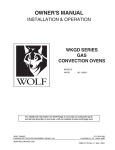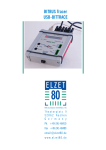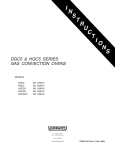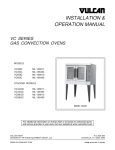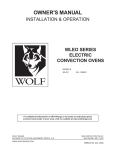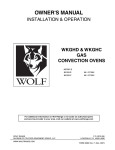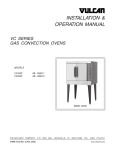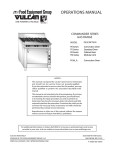Download Wolf ML-136758 Owner`s manual
Transcript
OWNER'S MANUAL INSTALLATION & OPERATION WLGO SERIES GAS CONVECTION OVENS MODELS WLGO ML-136758 For additional information on Wolf Range or to locate an authorized parts and service provider in your area, visit our website at www.wolfrange.com WOLF RANGE DIVISION OF ITW FOOD EQUIPMENT GROUP, LLC WWW.WOLFRANGE.COM 3600 NORTH POINT BLVD. BALTIMORE, MD 21222 FORM 32708 (Aug. 2008) IMPORTANT FOR YOUR SAFETY THIS MANUAL HAS BEEN PREPARED FOR PERSONNEL QUALIFIED TO INSTALL GAS EQUIPMENT, WHO SHOULD PERFORM THE INITIAL FIELD START-UP AND ADJUSTMENTS OF THE EQUIPMENT COVERED BY THIS MANUAL. POST IN A PROMINENT LOCATION THE INSTRUCTIONS TO BE FOLLOWED IN THE EVENT THE SMELL OF GAS IS DETECTED. THIS INFORMATION CAN BE OBTAINED FROM THE LOCAL GAS SUPPLIER. IMPORTANT IN THE EVENT A GAS ODOR IS DETECTED, SHUT DOWN UNITS AT MAIN SHUTOFF VALVE AND CONTACT THE LOCAL GAS COMPANY OR GAS SUPPLIER FOR SERVICE. FOR YOUR SAFETY DO NOT STORE OR USE GASOLINE OR OTHER FLAMMABLE VAPORS OR LIQUIDS IN THE VICINITY OF THIS OR ANY OTHER APPLIANCE. Improper installation, adjustment, alteration, service or maintenance can cause property damage, injury or death. Read the installation, operating and maintenance instructions thoroughly before installing or servicing this equipment. IN THE EVENT OF A POWER FAILURE, DO NOT ATTEMPT TO OPERATE THIS DEVICE. © WOLF RANGE, 2008 –2– Installation, Operation and Care of WLGO SERIES GAS CONVECTION OVENS KEEP THIS MANUAL FOR FUTURE REFERENCE GENERAL Wolf Range Gas Convection Ovens are produced with quality workmanship and material. Proper installation, usage and maintenance of your oven will result in many years of satisfactory performance. It is suggested that you thoroughly read this entire manual and carefully follow all of the instructions provided. Models WLGO Series feature a solid state temperature control. One-hour dial timer and buzzer and two-speed 1/2 HP (0.37 kw) blower motor are standard equipment. Porcelain interior is standard. The burner input rating for each oven is 44,000 BTU/hr. Oven doors open independently (standard). All ovens are furnished with 5 racks. The standard 120 V, 60 Hz, 1 PH ovens include cord and plug. Optional electrical specifications require hard wire connection. Wolf Range offers a stacking kit for mounting one oven on top of another as an option. Other available options include: additional oven racks and open stand with lower storage rack. FEATURES AND OPTIONS Model Thermostat Timer Oven Lights Legs Stand with Storage Rack Voltage WLGO Solid State 1 Hr. Std. Std. 253/4 (654 mm) Opt. 120/60/1 Std. INSTALLATION Before installing, verify that the electrical service and type of gas supply (natural or L. P. gases) agree with the specifications on the rating plate, located behind the top trim panel on the front of the oven. If the supply and equipment requirements do not agree, do not proceed with the installation. Contact your dealer or Wolf Range immediately. UNPACKING Immediately after unpacking, check for possible shipping damage. If the oven is found to be damaged, save the packaging material and contact the carrier within 15 days of delivery. Carefully unpack the oven and place in a work-accessible area near to its final installed position. Do not use the doors or their handles to lift the oven. –3– LOCATION The equipment area must be kept free and clear of combustible substances. When installed, minimum clearance from combustible construction must be 1 inch (25 mm) at the left side, 4 inches (102 mm) at the right side and 6 inches (152 mm) at the rear. Minimum clearance from noncombustible construction must be 0 inch (0 cm) at the left side, 4 inches (102 mm) at the right side and 6 inches (152 mm) at the rear. The oven may be installed on combustible floors. The installation location must allow adequate clearances for servicing and proper operation. There must be 18 inches (457 mm) of clearance on the right side of the oven from any open flame. The oven must be installed so that the flow of combustion and ventilation air will not be obstructed. Adequate clearance for air openings into the combustion chamber must be provided. Make sure there is an adequate supply of air in the room to allow for combustion of gas at the oven burners. Do not permit fans to blow directly at the oven. Wherever possible, avoid open windows next to the oven. Avoid wall-type fans which create air cross currents within the room. INSTALLATION CODES AND STANDARDS In the United States of America: 1. State and local codes. 2. National Fuel Gas Code, ANSI/Z223.1/NFPA #54 (latest edition). Copies may be obtained from The American Gas Association, Inc., Accredited Standards Committee Z223 @ 400 N. Capital St. NW, Washington, DC 20001 or the Secretary Standards Council, NFPA, 1 Batterymarch Park, Quincy, MA 02169-7471. NOTE: In the Commonwealth of Massachusetts, All gas appliances vented through a ventilation hood or exhaust system equipped with a damper or with a power means of exhaust shall comply with 248 CMR. 3. Vapor Removal From Cooking Equipment, NFPA-96 (latest edition). Copies may be obtained from The National Fire Protection Association, Batterymarch Park, Quincy, MA 02169-7471. 4. National Electrical Code, ANSI/NFPA-70 (latest edition). Copies may be obtained from The National Fire Protection Association, Batterymarch Park, Quincy, MA 02169-7471. In Canada: 1. Local codes. 2. CSA B149.1 Natural Gas and Propane Installation Code. 3. CSA C22.1 Canadian Electric Code (latest edition). The above are available from the Canadian Standard Association, 5060 Spectrum Way, Suite 100, Mississauga, Ontario, Canada L4W 5N6. –4– INSTALLING BASIC OVEN The basic oven must be installed on legs or be mounted on a modular stand. Installations on concrete bases or other supports restricting air circulation underneath the oven is not advisable and may void the warranty. Ovens Mounted on Casters Ovens mounted on casters must use a flexible connector (not supplied by Wolf) that complies with the Standard for Connectors for Movable Gas Appliances, ANSI Z21.69 • CSA 6.16 and a quickdisconnect device that complies with the Standard for QuickDisconnect Devices for Use With Gas Fuel, ANSI-Z21.41 • CSA 6.9. In addition, adequate means must be provided to limit movement of the appliance without depending on the connector and the quickdisconnect device or its associated piping to limit appliance movement. Attach the restraining device at the rear of the oven as shown in Fig. 1. CONNECT GAS LINE STRAIN RELIEF HERE Remove two screws from the rear of the oven and install the tiedown strap shipped with the casters using these screws (Fig. 1). Attach the gas line strain relief to the tie-down strap at the rear of the oven (Fig. 1). PL-53563 Fig. 1 If disconnection of the restraint is necessary, turn off the gas supply before disconnection. Reconnect this restraint prior to turning the gas supply on and returning the oven to its installation position. Separate instructions for installing casters to the oven are included with the casters. Note: If the oven is installed on casters and is moved for any reason, it is recommended that the oven be releveled front to back and side to side. Assembling the Legs to the Oven The legs must be installed on the bottom of the oven. Gently position the oven on its side, taking care not to scratch or damage it. BACK Attach each of the four leg assemblies to the bottom of the oven with the 24 bolts and lockwashers (six per leg). Carefully raise the oven to its normal position. ASSEMBLING THE STAND TO THE OVEN Attach each of the four leg assemblies to the bottom of the oven with the 24 bolts and lockwashers (six per leg). Carefully raise the oven to its normal position. Attach the undershelf to the legs with eight bolts and lockwashers (two per leg). Install the rack guides into the undershelf at desired locations (for pan or flat rack), then attach the rack supports to the top end of the rack guides. Attach rack supports to the leg assembly by removing one middle bolt and reattaching back through the end holes in the rack support (Fig. 2). FRONT RACK SUPPORT RACK GUIDE PL-56178 Fig. 2 –5– ASSEMBLING STACKED OVENS (OPTIONAL) STACKING FLUE Unpack the ovens and stack kit. Position the oven to be used as the bottom oven on its back for access to the oven bottom, taking care not to scratch or damage it. The gas pipe protrudes beyond the back; provide for this when the oven is tipped back by resting it on suitable spacers (2 x 4's, etc.). Attach the four leg assemblies with the 24 bolts and lockwashers (six per leg). Place the lower oven (with legs) on the floor and remove two 7/16 inch (11 mm) diameter knockouts on each side of the top cover. Remove vent guard and discard it. Move the oven with legs to the installed position and place upper oven on top of lower oven using the locating studs. Install the stacking flue (Fig. 3) with the four screws provided. Connect the piping between the top oven and bottom oven. For all gas supply connections, pipe joint compound must be resistant to the action of propane gases. PL-53564 Fig. 3 LEVELING Make sure that the oven racks are level in the final installed position. If the oven is installed on legs, turn the adjustable feet in or out to level the oven front-to-back and side-to-side. If the oven is installed on casters, loosen set screws and turn casters in or out to level the oven front-to-back and side-to-side. Retighten set screws after leveling. GAS CONNECTION Gas supply connections and any pipe joint compound must be resistant to the action of propane gases. Location of the gas inlet is at the rear of the oven. Codes require that a gas shutoff valve must be installed in the gas line ahead of the oven. Connect gas supply after leveling the oven. The gas supply line must be at least the equivalent of 3 /4 inch (19 mm) iron pipe. Make sure the pipes are clean and free of obstructions, dirt or pipe joint compound. The ovens are equipped with fixed burner orifices which coincide with installation elevation. The oven is provided with a regulator integral to the gas solenoid valve and requires no external regulator. Natural gas pressure regulators are preset for 3.5 inches W.C. (Water Column) (0.9 kPa); propane gas pressure regulators are preset for 10 inches W.C. (2.5 kPa). Prior to lighting, check all joints in the gas supply for leaks. Use soap and water solution. Do not use an open flame. A. Check all joints prior to the gas valve (solenoid) before lighting unit. B. Check all joints beyond gas valve (solenoid) after unit is lit. After piping has been checked for leaks, all piping receiving gas should be fully purged to remove air. –6– TESTING THE GAS SUPPLY SYSTEM When gas supply pressure exceeds 1/2 psig (3.45 kPa), the oven and its individual shutoff valve must be disconnected from the gas supply piping system. When gas supply pressure is 1/2 psig (3.45 kPa) or less, the oven should be isolated from the gas supply system by closing its individual manual shutoff valve. BURNER AIR ADJUSTMENT Although main burner air is adjusted before shipment, it should be checked at the time of installation. Excessive air will cause flames to lift off a burner when cold or may cause flash-back during normal cycling of oven, particularly when propane gas is used. Insufficient air will cause flames to burn with a yellow tip and result in carbon accumulation in the flame chamber and heat exchanger tubes. Contact your local Wolf Range servicer if required. VENT SYSTEM DO NOT obstruct the flow of flue gases from the flue located on the rear of the oven. It is recommended that the flue gases be ventilated to the outside of the building through a ventilation system installed by qualified personnel. Ovens may use an optional down draft diverter flue method. This optional down draft diverter must be purchased from the oven manufacturer and vented to the outside; otherwise, the installation of any such device will void all oven certifications and warranties. When the diverter is supplied, it may be connected to a Type “B” vent. NOTE: Check with state and local codes governing the installation area to insure that a down draft diverter and Type "B" vent is acceptable before installing. From the termination of the flue to the filters of the hood venting system, a minimum clearance of 18 inches (457 mm) should be maintained. Information on the construction and installation of ventilating hoods may be obtained from Vapor Removal from Cooking Equipment, NFPA Standard No. 96 (latest edition), available from the National Fire Protection Association, Batterymarch Park, Quincy, MA 02269. –7– ELECTRICAL CONNECTIONS Electrical and grounding connections must comply with the applicable portions of the National Electrical Code and/or other local electrical codes. Appliances equipped with a flexible electric supply cord are provided with a three-prong grounding plug. It is imperative that this plug be connected into a properly grounded three-prong receptacle. If the receptacle is not the proper grounding type, contact an electrician. Do not remove the grounding prong from this plug. WLGO series ovens with 120 V/60 Hz/1 PH electrical specification are equipped with a cord and plug as standard equipment. A wiring diagram is located on the inside of the control housing. ELECTRICAL DATA Model V/Hz/PH Minimum Circuit Ampacity Maximum Protective Device AMPS WLGO 120/60/1 15 Compiled in accordance with the National Electrical Code, NFPA-70 (latest edition). –8– OPERATION The oven and its parts are hot. Use care when operating, cleaning or servicing the oven. WLGO SERIES CONTROLS MASTER SWITCH ON OFF OVEN COOL ON HEAT IGNITION THERMOSTAT 350 325 150 200 375 400 300 425 275 450 250 475 500 250 225 150 F 100 C TEMPERATURE TIMER OFF 0 OFF 60 5 0 10 15 55 20 50 25 45 40 35 FAN SPEED HI 30 LIGHTS ON LO OFF LO PL-53558 Master Switch ON — Turns oven control circuits on. OFF — Turns oven control circuits off. OVEN COOL — Allows the fan motor to run with the doors ajar to speed oven cooling. On Light (Amber) — Lit when Master Switch is ON. Heat Light (White) — Comes on and goes off when the burner cycles on and off. Ignition Light (Red) — Comes on if burner fails to ignite. When lighting the oven, the IGNITION light flashes. Thermostat — Controls oven temperature during cooking operation. Timer (1 Hr.) — Sets the Bake time. Buzzer sounds continuously after timer counts down to 0. Oven does not turn off. Turn Timer to OFF to stop buzzer. When oven is not in use, keep Timer at OFF position. Fan Speed Switch — Allows you to select HI or LO fan speed. Lights Switch — Turns the lights in the oven ON or OFF. –9– BEFORE FIRST USE Before using the oven for the first time, it must be burned in to release any odors that might result from heating the new surfaces in the oven. 1. Using a clean, damp cloth, wipe the inside of the oven including the racks. See LIGHTING THE WLGO SERIES OVENS below to light the oven, then proceed to step 2. 2. Close the oven doors, push the Master Switch to ON, turn the Temperature to 300°F (149°C), and allow the oven to cycle for 2 hours or until no odor is detected before pushing the Master Switch to OFF. LIGHTING THE WLGO SERIES OVENS 1. Turn the main gas supply ON. 2. Push Master Switch to ON. 3. If the oven fails to light, push the Master Switch to OFF, wait 5 minutes for retrial. SHUT DOWN INSTRUCTIONS 1. Push Master Switch to OFF. EXTENDED SHUTDOWN Repeat Steps 1 through 3 of End of Day. Unplug oven and shut off manual gas valve. USING THE WLGO SERIES OVENS Preheating 1. Select the proper rack arrangement for the product to be cooked. Refer to RACK ARRANGEMENTS section in this manual. 2. Make sure the doors are closed. 3. Push the Master Switch to ON. The amber ON light will come on, indicating that power to the oven is on. 4. Set the two-speed Fan Speed switch to desired setting. 5. Set Temperature as desired. The HEAT light will come on and remain on until the oven reaches set temperature (approximately 10 to 15 minutes for settings from 300°F (149°C) to 400°F (204°C)). Refer to SUGGESTED COOKING GUIDELINES for temperatures and times for various products. 6. Prepare product and place in suitable pans. When the white HEAT light goes off, the oven has reached the desired preheat temperature. Cooking 1. Open the doors and load the product into the oven. Place pans in the center of the racks. Close the doors. 2. Set the Timer. After the preset time lapses, turn the Timer to OFF to stop the alarm. 3. When product is done, open the doors and carefully remove cooked product from the oven. Care should be taken when wiping up spills, as oven is still hot. – 10 – End 1. 2. 3. 4. of Day Turn Temperature to lowest setting. Push the Master Switch to OVEN COOL. Leave door ajar while the fan is on to cool the oven. When oven has cooled sufficiently, push the Master Switch to OFF. Turn the gas valve OFF and clean oven. CONSERVING ENERGY • Turn off unused equipment. • Adjust menu patterns and cooking/baking schedules for optimum equipment use. • Reduce thermostat settings in slack periods since gas equipment heats up and recovers quickly. • Preheat only to required cooking temperature for specific food — not higher. • Do not open the oven door unless absolutely necessary. • Keep area around the oven door clean and free of food particles. • Any obstruction that prevents the door from closing completely will adversely affect oven efficiency. HIGH LIMIT SWITCH All ovens are equipped with a high limit switch, which senses the temperature of the oven to prevent overheating. The high limit switch operates independently and will automatically shut the oven down should the primary control fail. If this situation occurs, DO NOT attempt to bypass the high limit. Shut the oven down and contact your local Wolf Range authorized service agency. – 11 – RACK ARRANGEMENTS All models are supplied with five racks and have a maximum operating capacity of six racks per oven. The 11-position rack supports provide for maximum flexibility and proper rack spacing. The following arrangements are recommended. The position numbers are in numerical sequence starting at the bottom (Fig. 4). #11 #10 #9 Arrangement #1 — Five racks in positions #2, #4, #6, #8 and #10 for cookies or reconstitution of frozen lunches at maximum capacity. These are also the recommended positions for general baking in sheet pans with products not over 21/2 inches (64 mm) high. #8 #7 #6 #5 #4 Arrangement #2 — Four racks in positions #1, #4, #7 and #10 are for general baking in sheet pans, muffin pans, pie or cake tins and pudding pans 31/2 inches (89 mm) high with products not over 4 inches (102 mm) high. This arrangement can also be used for casseroles or meat dishes in #200 series food service pans 12 x 20 x 21/2" (305 x 508 x 64 mm). #3 #2 #1 PL-52806 RACK POSITION Fig. 4 Arrangement #3 — Three racks in positions #1, #5 and #9 are for baking breads or cakes in loaf or tube pans and high meringue pies. This arrangement can also be used for casseroles, meat dishes or cooking in pans up to 51/2 inches (140 mm) deep with products up to 6 inches (152 mm) high. Arrangement #4 — Two racks in positions #1 and #6 are for cooking turkeys and other roasts up to 7 inches (178 mm) high. With the rack in position #1, there is limited space for a water pan (see cooking chart in this manual). When mixed loads or partial loading is regular practice, some users have developed other rack arrangements to suit their particular needs. SPECIAL PROCEDURES FOR BAKING Yeast Bread: Cooking starts immediately in the convection oven. Yeast breads do not usually rise as much in a convection oven as in a conventional oven. Therefore it is usually necessary to allow fuller proof, 21/2 to 3 times increase in volume, for best results. Pies: When baking pies in your convection oven, three or four pies should be put on an 18 x 26" sheet or bun pan. This procedure helps the bottom crust to bake, makes handling easier and reduces the possibility of boilover spoiling the appearance of the pies on the lower racks. PROPER UTENSILS The use of proper utensils can enhance oven operation. Medium and lightweight pans allow the product to warm faster. Roast meats in shallow pans deep enough to hold all juices yet allow free air circulation. – 12 – RECOMMENDED TEMPERATURES AND TIMES FOR ROASTING Meat roasting is most satisfactory at temperatures of 225 to 325°F (107 to 163°C) for beef, lamb, poultry and ham; 325°F (163°C) for fresh pork as recommended by USDA and American Meat Institute. A pan, approximately 12 x 20 x 1" (305 x 508 x 25 mm) full of water, may be placed in the oven bottom. This water supplies humidity to reduce shrinkage. Water should be added if necessary during roasting. Roasting pans should be no deeper than necessary to hold drippings (usually 2 to 21/2" (51 to 64 mm)). Cooking time and shrinkage may vary with roasting temperature, cut, grade of meat and degree of doneness. Smaller cuts will generally show greater time savings than larger cuts at a given temperature. ROASTING TEMPERATURE CHART TEMP PRODUCT °F (°C) APPROXIMATE TIMES Standing Rib Roast — Oven Ready 250 (121) Rolled Rib Roasts — 20 to 22 lb (9.1 to 10 kg) Veal Roast — 15 lb (6.8 kg) 275 300 (135) (149) 3 4 4 3 Turkeys — 15 to 20 lb (6.8 to 9.1 kg) Meat Loaf — 8 to 10 lb (3.6 to 4.5 kg) 300 350 (149) (177) 3 Hrs. 45 to 60 Minutes to 4 Hrs. — Rare to 41/2 Hrs. — Med. Hrs. — Med. Hrs. — Med. Well COOKING HINTS Forced air convection cooking is faster than conventional oven cooking, and therefore overcooking is more common. Do not cook products faster than is practical for the best results. Since forced air convection supplies heat to the surface of the product, the thicker or more massive a product is for its type, the longer it will take to absorb enough heat to cook. SUGGESTED BAKING GUIDELINES The oven will cook or bake full or partial loads at standard recipe temperatures. As with any oven, you may wish to use a temperature of up to 25°F (-4°C) higher or lower than the recipe for the particular product result that you prefer. Since recipes and foods are subject to many variations and tastes, the guidelines regarding Times and Temperatures in this manual are SUGGESTIONS ONLY. Experiment with your food products to determine the cooking temperatures and times that give you the best results. Once established, convection oven time and temperature settings should be noted on your recipe. – 13 – RECOMMENDED TEMPERATURES, TIMES AND NUMBER OF RACKS FOR BAKING PRODUCT Cakes Sheet Cakes 18 x 26 x 1" (457 x 660 x 25 mm) pan Scaled 41/2 to 6 lb (2 to 2.7 kg)/pan Scaled 6 to 71/2 lb (2.7 to 3.4 kg)/pan Sheet Cakes 18 x 26 x 2" (457 x 660 x 51 mm) pan Scaled 10 to 12 lb (4.5 to 5.4 kg)/pan Or, two 12 x 18 x 2" (305 x 457 x 51 mm) pans Scaled 5 to 6 lb (2.3 to 2.7 kg)/pan. TEMPERATURE °F (°C) TIME IN MINUTES NO. OF RACKS 325-360 335-350 (163-182) (168-177) 20 to 23 22 to 25 5 4 300-325 300-325 (149-163) (149-163) 25 to 35 25 to 35 4 3 Angel or Sponge Cakes Sheet Pans 18 x 26 x 1" (457 x 660 x 25 mm) Scaled 5 to 6 lb (2.3 to 2.7 kg)/pan Loaf or Tube Pans 300-325 315-340 (149-163) (157-171) 15 to 20 20 to 30 4 3–4 Cupcakes Frozen Fruit Pies 350-400 350-375 (177-204) (177-191) 6 to 12 30 to 45 4 3–4 Pumpkin or Custard Pies Cobblers 12 x 18 x 2" (305 x 457 x 51 mm) or 12 x 20 x 21/2" (305 x 508 x 64 mm) Meringue Pies Fruit Turnovers 18 x 26 x 1" (457 x 660 x 25 mm) pans 300-350 (149-177) 30 to 45 3–4 350-400 (177-204) 30 to 45 3–4 350-425 (177-218) 6 to 10 2–4 350-375 (177-191) 15 to 25 3–5 350-400 350-400 (177-204) (177-204) 6 to 12 6 to 15 3–5 3–5 350 (177) 12 to 20 4–5 Rolls — 1 oz 11/2 to 21/2 oz 350-400 350-400 (177-204) (177-204) 5 to 10 8 to 15 3–4 3–4 Loaf Bread — 1 lb (453.4 g) 325-375 (163-191) 20 to 40 3(30) Pans 2(20) Pans Sweet Rolls & Danish Pastry Biscuits — Rolled 1/2" (13 mm) Thick Muffins 18 x 26 x 1" (457 x 660 x 25 mm) pan, 5 to 7 lb (2.3 to 3.2 kg)/pan 325-375 350-400 325-375 335-400 (163-191) (177-204) (163-191) (168-204) 5 to 15 5 to 15 6 to 18 10 to 20 3–4 3–4 3–4 4 18 x 26 x 2" (457 x 660 x 51 mm) pan, 8 to 20 lb (3.6 to 9 kg)/pan 335-400 (168-204) 15 to 25 4 335-385 (168-196) 10 to 20 3–4 NOTE: Pies and cobblers; fruit, custard, and pumpkin pies in pie pans should be placed on 18 x 26 x 1" (457 x 660 x 25 mm) pans for baking. Cookies Rolled or Pressed Drop Brownies Yeast Breads NOTE: Yeast breads should be fully proofed for best results. Corn Muffins – 14 – REHEATING PREPARED FOODS PRODUCT TEMPERATURE °F (°C) TIME IN MINUTES NO. OF RACKS 10 to 12 10 to 20 2–5 2–5 350-400 (177-204) 20 to 30 2–5 350-400 (177-204) 350-375 (177-191) 6 to 10 8 to 15 2–4 2–4 Frozen TV Dinners Frozen Entrees 3 /4 to 1" (19 to 25 mm) Thick Frozen Meals, 8 oz Foil Pkg. Fish Sticks & Portions Frozen Breaded, 1 oz 21/2 to 3 oz Chicken Pieces Broiled or Oven Fried 2 to 21/2 lb (0.9 to 1.1 kg)/bird 21/2 to 3 lb (1.1 to 1.4 kg)/bird 350-400(177-204) 300-350(149-177) 375-425 (191-218) 350-400 (177-204) 8 to 15 15 to 25 2–5 2–4 Lobsters — 1 to 11/2 lb (0.45 to 0.7 kg) Lobster Tails — Frozen 1 /2 to 3/4 lb (0.2 to 0.3 kg) Hamburger Patties 8 per lb, Med. to Well Done 400-450 (204-232) 8 to 14 2–4 350-400 (177-204) 10 to 15 2–4 400-450 (204-232) 5 to 6 2–6 400-450 (204-232) 375-450 (191-232) 7 to 10 8 to 12 2–6 2–6 325-375 (163-191) 325-375 (163-191) 15 to 25 20 to 35 2–4 350-400 (177-204) 5 to 6 6 per lb 4 per lb CASSEROLES Food Service Pans 2 to 3" (51 to 76 mm) deep 3 to 4" (76 to 102 mm) deep Ramekins or Foil Pans Up to 11/2" (38 mm) deep Frozen 4–5 2–4 10 to 15 MISCELLANEOUS PRODUCTS Baked Potatoes 120 count per 50 lb (22.7 kg) 100 count per 50 lb (22.7 kg) 80 count per 50 lb (22.7 kg) 400-450 (204-232) 400-450 (204-232) 400-425 (204-218) 20 to 25 25 to 40 30 to 45 2–5 2–5 2–5 Pizza — Frozen or With Prebaked Crust 425-475 (218-246) 5 to 10 2–4 Grilled Cheese Sandwiches 400-425 (204-218) 8 to 10 2–4 – 15 – CLEANING Disconnect the electrical power to the machine and follow lockout / tagout procedures. Allow the oven to cool before cleaning. Heat Circulation Tube The heat circulation tube, located in the back of the oven cavity, should never be blocked. The heat circulation tube should be kept clean at all times for proper operation of the oven. Clean with standard oven cleaner at least once a week. Be sure to thoroughly clean all cleansing solution off before using the oven again. It is also recommended that the oven be run at 400°F (204°C) for 20 minutes before using to burn off any cleaning solution that was not thoroughly rinsed from the heat circulation tube. Daily Exterior stainless steel front panels and aluminized sides and top oven panels should be cleaned with a damp cloth. Stubborn soil may be removed with detergent. (DO NOT USE DAWN®.) Rinse thoroughly and wipe dry with a soft, clean cloth. Clean porcelain oven interior daily with soap or detergent and water. Rinse thoroughly and wipe dry with a soft, clean cloth. Nickel-plated racks and rack supports are dishwasher-safe and may be removed for cleaning. For exterior front panel burned-on foods and grease which resist simple soap and water cleaning, an abrasive cleanser (scouring powder) mixed into a paste may be used. Apply with stainless steel wool or sponge, always rubbing with the grain. This treatment is equally effective for heat tint (slightly darkened areas caused by oxidation). Again, remember to rub in the direction of the metal grain lines. Rinse with clear water and dry with a soft cloth. Do not use scouring powder on the aluminized sides and top. Do not use scouring powder on the glass window; it will scratch and fog the glass. After processing some foods at low temperatures, odors may linger in the oven. These odors may be cleared by setting the temperature to 500°F (260°C) and allowing the oven to run unloaded for 30 to 45 minutes. GUIDELINES FOR MAINTAINING STAINLESS STEEL SURFACES There are three basic things that can break down the surface layer of stainless steel and allow corrosion to develop: 1) Abrasion; 2) Deposits and water and 3) Chlorides. Avoid abrasion from rubbing with steel pads, wire brushes or scrapers that can leave iron deposits on stainless steel; instead, use plastic scouring pads or soft cloths. For stubborn stains, use products such as Cameo, Talc or Zud First Impression. Always rub parallel to the polish lines or with the grain. Hard water can leave deposits that promote rust on stainless steel. Treated water from softeners or certain filters can eliminate these mineral deposits. Deposits from food must be properly removed by cleaning. Use mild detergent and nonchloride cleaners. Rinse thoroughly. Wipe dry. If using chloride -containing cleaners or sanitizers, rinse repeatedly to avoid stainless steel corrosion. Where appropriate, apply a polish recommended for stainless steel for extra protection and lustre. – 16 – MAINTENANCE The oven and its parts are hot. Use care when operating, cleaning or servicing the oven. Disconnect the electrical power to the machine and follow lockout / tagout procedures. LUBRICATION The fan motor comes with sealed bearings and requires no lubrication. VENT Periodically check the flue, when the oven is cool, to be sure it is free of obstructions. REPLACING LAMPS • • • • • Allow oven to cool. Remove all racks by pulling forward, lifting up and out. Unscrew glass dome from light body. Replace the bulb. Reassemble glass dome and racks. – 17 – TROUBLESHOOTING Problem Possible Cause Suggested Corrective Action Uneven browning or overcooked edges. 1. Oven is too hot. 1. Reduce temperature setting (refer to Cooking Guidelines). 2. Too many racks used. 2. Use fewer racks to allow better circulation. 1. Oven is not level. 1. Level oven racks - side to side and front to back. The rack should be level side to side and level to 1/8" low at the front from front to back. 2. Sheet pans are warped. 2. Keep pans used for baking batter separate from general purpose pans. If any pan shows a tendency to warp, remove it from the baking group. Product pulling to edge of pan or spilling. Excessive shrinkage. 1. Failure to maintain water 1. Place pan of water in bottom of oven measuring 12 x 20 x 1" (30.5 x 51 x 2.5 cm). in oven. 2. Roasting temperature too high. Ignition light remains lit for more than 20 seconds after 3 trials. No gas supply. 2. Reduce temperature. • Turn oven off for 5 minues before attempting to relight. • Check gas supply valves to be sure they are open SERVICE AND PARTS INFORMATION To obtain service and parts information concerning this model, contact the Authorized Wolf Range Service Agency in your area (refer to our website, www.wolfrange.com for a complete listing of Authorized Service and Parts depots). When calling for service, the following information must be available: model number, serial number, manufacture date (MD) and voltage. – 18 – – 19 – FORM 32708 (Aug. 2008) – 20 – PRINTED IN U.S.A.




















